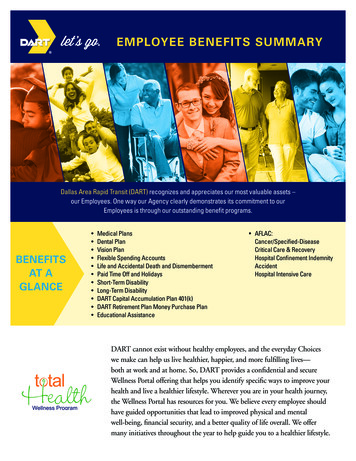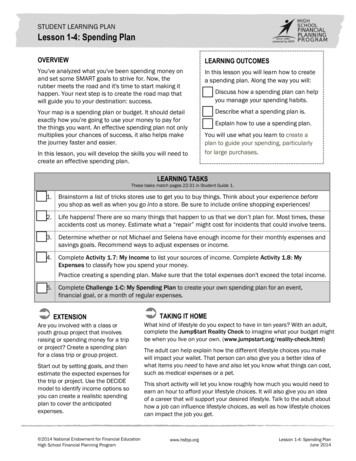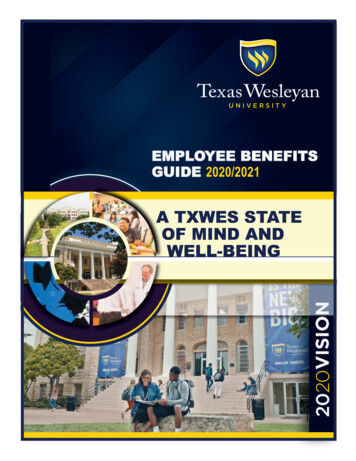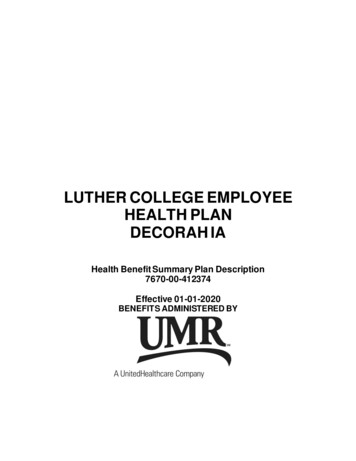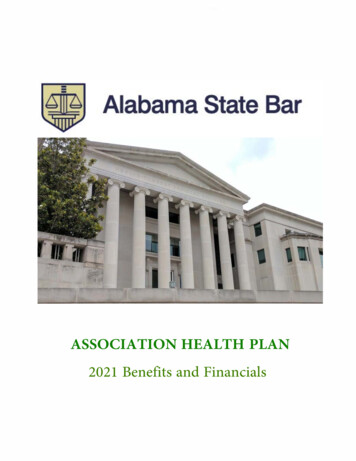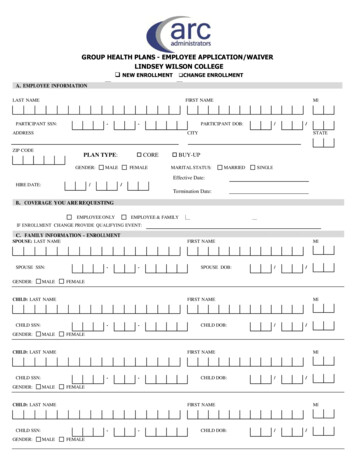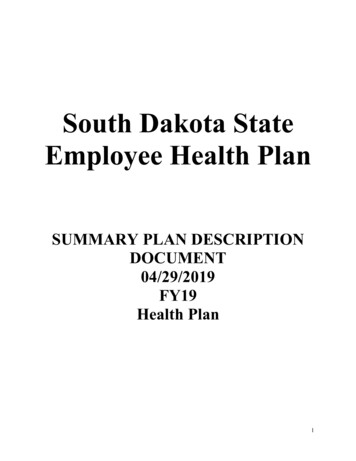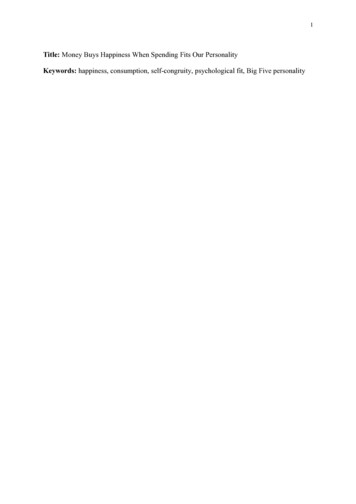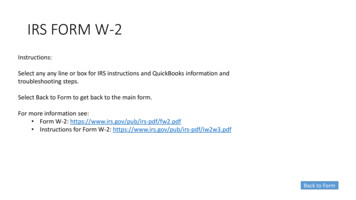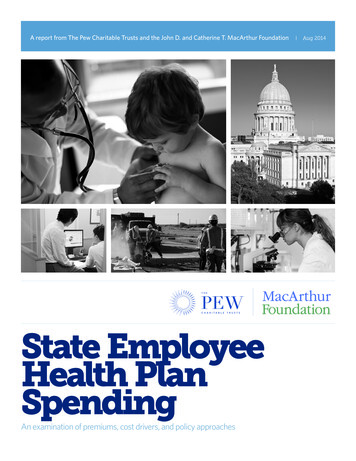
Transcription
A report from The Pew Charitable Trusts and the John D. and Catherine T. MacArthur FoundationState EmployeeHealth PlanSpendingAn examination of premiums, cost drivers, and policy approachesAug 2014
The State Health Care Spending Project, an initiative of The Pew Charitable Trusts and the John D. and CatherineT. MacArthur Foundation, helps policymakers better understand how much money states spend on health care,how and why that amount has changed over time, and which policies are containing costs while maintaining orimproving health outcomes. For additional information, visit www.pewtrusts.org/healthcarespending.The Pew Charitable TrustsSusan K. Urahn, executive vice presidentMaria SchiffEllyon BellSamantha ChaoKavita ChoudhryKil HuhMatt McKillopJohn D. and Catherine T.MacArthur FoundationValerie Chang, director for policy researchMeredith Klein, communications officerExternal reviewersThe report benefited from the insights and expertise of two external reviewers: Paul Fronstin, Ph.D., director, HealthResearch and Education Program, Employee Benefit Research Institute; and John Brouder, partner at Boston BenefitPartners. These experts provided feedback and guidance at critical stages in the project. Although they havescreened the report for accuracy, neither they nor their organizations necessarily endorse its findings or conclusions.AcknowledgmentsWe want to express our gratitude to Bob Carey of RLCarey Consulting and Bob Cosway and Barbara Abbott ofMilliman Inc. for their invaluable partnership. We appreciate Andrew Bender, Katie Selenski, and Emily Levettfor their assistance with fact checking. Thank you to the following current and former Pew colleagues for theircontributions to this report: Michael Ettlinger, Jeremy Ratner, Michelle Blackston, Lauren Dickinson, and LisaGonzales for their editorial input; and Gaye Williams, Dan Benderly, Sara Flood, Laura Woods, Lisa Plotkin, andCarol Hutchinson for their work preparing this report for publication.In September 2014, this report was updated to include revised data for Alabama, Florida, Illinois, Maine, Nevada,New Jersey, North Dakota, and Wisconsin, as well as affected national averages. Further, language was added tothe report to clarify states’ total annual employee health plan expenditures. In 2013, states and their employeespaid 30.7 billion to insure 2.7 million employee households. States paid 25.1 billion of this total.Contact: Michelle Blackston, communications officer Email: mblackston@pewtrusts.org Phone: 202-540-6627This report is intended for educational and informational purposes. References to specific policymakers or companies have been includedsolely to advance these purposes and do not constitute an endorsement, sponsorship, or recommendation by The Pew Charitable Trusts orthe John D. and Catherine T. MacArthur Foundation.
Table of contents1Overview4Glossary of terms6Premium comparisons15Strategies to influence costs30Conclusion31Appendix A: Milliman Atlas of Public Employer Health Plans32Appendix B: Methodology35Appendix C: Data tables42Endnotes
OverviewIn 2012, 865 billion was spent in the United States to insure 169 million people through employer-sponsoredhealth insurance, which represented 31 percent of all health care spending. Public and private employerscontributed 630 billion, or 73 percent, toward this total; employees picked up the difference.1 Employersponsored insurance is a vital element of the American health care landscape, and an important componentof employee compensation. It helps provide people with access to affordable care, protects workers and theirfamilies from unaffordable medical costs, and serves as a critical funding source for virtually every medicalinstitution.The cost of health insurance has become a leading budget driver for employers of all sizes and in all sectors. From1992 to 2012, the average cost of insuring each employee and dependent doubled, after adjusting for inflation.2This increase has led many employers—including states—to review the benefits they provide, benchmark theirofferings to comparable employers, and seek ways to control costs.Health insurance costs have become a significant portion of states’ overall health care spending, second only toMedicaid.3 Nevertheless, little has been known about how states’ employee health plans and costs compare withone another and with those of large, private sector employers.To provide policymakers and other stakeholders with information on state employee health care expenditures,as well as the factors underlying this spending, researchers from the State Health Care Spending Project—acollaboration between The Pew Charitable Trusts and the John D. and Catherine T. MacArthur Foundation—worked with actuaries from Milliman Inc. to produce a first-of-its kind analysis of the costs and characteristicsof state employee health plans.* Although meaningful state-to-state comparisons are complicated by a numberof factors, including who is covered (i.e., the number, age, and health of enrollees) and differences in health planbenefit design, this analysis offers a nationwide benchmark against which states can be compared.Milliman Atlas of Public Employer Health PlansMilliman Inc., a global actuarial firm, maintains a database built through the collection of publiclyavailable health insurance data from state and local governments. The Atlas contains key piecesof information, such as total premiums, employer and employee share of premiums, cost-sharingarrangements, number of enrollees, and total health care expenditures, among others. These dataprovide a solid base to establish national benchmarks and to make comparisons between states andamong plans within a state. Pew partnered with Milliman to access these data and benefited fromthe firm’s expertise and analysis.*Data for Pennsylvania were not available.1
The project found that in 2013:* States and their employees spent 30.7 billion to insure 2.7 million employee households,† a slight uptickin spending from 2011 and 2012—the earliest years for which Milliman compiled data—after adjusting forinflation. States paid 25.1 billion of this total. ‡ The average per-employee per-month premium for coverage of employees and dependents was 959. Statespaid 805 (84 percent) of the total, and employees covered the remaining 154 (16 percent). Employees paidan additional 70 per month, on average, in cost-sharing elements such as deductibles, copayments, andcoinsurance. The average per-employee premium masks sharp differences across the states. Arkansas, Mississippi, NewMexico, South Carolina, and South Dakota, for example, had relatively low per-employee premiums, whereasthe average per-employee premiums for Alaska, New Hampshire, New Jersey, Vermont, and Wisconsin werecomparatively high. One factor underlying differences in per-employee premiums is variation in “plan richness,” a commonlyused term of art within the actuarial community. Richness reflects the relative cost sharing between a healthplan and enrollees based on the required deductibles, copayments, and coinsurance. State health plans weregenerally “rich,” paying on average§ 92 percent of the typical enrollees’ health care costs. By way of context,these plans would be designated “platinum” plans within the new health insurance marketplaces.¶, 4 Annual deductibles—the amount employees must pay for covered health care services before the health planbegins to pay—are a significant determinant of plan richness. A common cost-containment strategy amongmany private sector employers in recent years has been the introduction of high-deductible health plans,which result in lower premiums. States have been relatively slower to offer such plans, and in those where theywere offered, relatively few employees chose to enroll in them. Nineteen states offered at least one plan withan annual deductible of 1,500 or more, up from 16 states in 2011. Among those 19 states, a median of7 percent of state employees enrolled in them. Nationwide, only 5 percent of state employees enrolled in sucha plan. Forty-eight percent were enrolled in plans with no deductible. Even after controlling for differences among states in average health plan richness and enrollee household size,a large range in premiums across the states remains. This suggests that other factors also have a substantial*Most state plan years extend from either January to December or July to June.†This analysis includes every state employee health plan and excludes local government employees, even if they were in the plan (i.e.,had the same benefit design and premiums). Milliman excluded school district employees on this basis, even in states that consideredlocal school employees to be state employees, and it included only those public university employees who were in a primary stateemployee plan. These totals do not include Pennsylvania, as its data were not available.‡Data for fiscal years 2011 to 2012 were converted to 2013 dollars using the Implicit Price Deflator for Gross Domestic Product included inthe Bureau of Economic Analysis’ National Income and Product Accounts.§Each state’s average actuarial value across plans was weighted by enrollment. This figure represents a nationwide numerical average.¶The Affordable Care Act created health insurance marketplaces that individuals and small businesses may use to shop for and comparehealth insurance plans. Plans in the marketplace are separated into four categories—bronze, silver, gold, or platinum—based on thepercentage of an average enrollee’s overall costs for which the health plans pay. The percentages are roughly 60 percent, 70 percent,80 percent, and 90 percent, respectively. A tax credit applied immediately upon enrollment offsets the cost of some enrollees’ premiums.Enrollees whose incomes are between 100 percent and 400 percent of the applicable federal poverty threshold may use advancepremium tax credits.2
effect on premiums, such as variation in provider prices and physician practice patterns,* as well as age andhealth status of employees. Because of the range of variables that influence spending, higher spending is notnecessarily an indication of waste, and lower spending is not necessarily a sign of efficiency.How states manage their employee benefits—as well as other elements of their employee compensationpackage—affects their fiscal health; their ability to recruit and retain qualified staff to deliver critical publicservices; and their employees’ physical, mental, and financial well-being. In addition, as states try to reform thehealth care payment and delivery systems within their borders, how they structure the health insurance of theiremployees can serve as a model for other employers.This report examines the project’s findings on state employee health care spending, explores the factors drivingcosts and states’ ability to influence these factors, and surveys a range of cost-containment strategies. Thesedata and analysis offer important information as policymakers seek the best way to make their employee benefitsystems effective, affordable, and sustainable.*Variation in physician practice patterns refers to the differences in treatment approaches physicians take when treating patients withsimilar conditions. This variation commonly involves the frequency that tests and diagnostic imaging are ordered, how often patients arereferred to specialists, physicians’ pharmaceutical prescribing patterns, and other treatment decisions.The State Health Care Spending 50-State Study Report SeriesThe State Health Care Spending Project, a collaboration between The Pew Charitable Trusts and the JohnD. and Catherine T. MacArthur Foundation, is examining seven key areas of state health care spending—Medicaid, the Children’s Health Insurance Program, substance abuse treatment, mental health services,prison health care, active state government employee benefits, and retired state government employeebenefits. The project will provide a comprehensive examination of each of these health programs that statesfund. The programs vary by state in many ways, so the research will highlight those variations and someof the key factors driving them. The project is concurrently releasing state-by-state data on 20 key healthindicators to complement the programmatic spending analysis. For more information, see care-spending.3
Glossary of termsAnnual deductible: The amount employees pay for covered health care services before the health plan beginsto pay. For example, if an employee has an annual deductible of 250, the health plan will not pay any amountfor covered services that are subject to the deductible until the employee has paid 250 toward those services.The Affordable Care Act requires most health plans to cover a minimum set of preventive services without anymember cost sharing—including the annual deductible—when delivered by a network provider. Some states andother employers may elect to broaden their deductible-excluded services beyond the federal requirements.Insurance carrier: A company that provides health insurance plans—for example, Blue Cross Blue Shield, KaiserPermanente, and WellPoint.Copayment: A fixed amount employees pay directly to the health provider for services covered by their healthplan. The amount sometimes varies by the type of service or provider. For example, a copayment for a visit to aprimary care physician can be less than a copayment for a visit to a specialist.Coinsurance: An employee’s share of the cost of a service covered by the plan calculated as a percentage of the“allowed amount.” The allowed amount for a particular service is based on the contract between the health planand the network provider that performs the service. For example, if a plan’s allowed amount for an office visit toa particular primary care physician is 100, and the employee has met the annual deductible (if the plan requiresone), the employee’s coinsurance might be 20 percent ( 20). The remaining 80 is paid by the plan.Health plan: An arrangement—between employers and employees, for the purposes of this report—with aspecified set of health benefits and a stated premium applicable to all employees.Health reimbursement arrangement (HRA): Employer-funded account that employees can use to be reimbursedtax-free—often immediately with a debit card attached to the HRA—for a fixed amount of qualified medicalexpenses. If the employee leaves the employer without spending all of the money in an HRA, the employee maylose access to the HRA with the funds reverting to the employer. Some employers allow continued access to anHRA after job separation, particularly when employees retire.Health savings account (HSA): Account owned by the employee that can be funded with pretax contributionsfrom the employee and the employer. Like an HRA, the funds in an HSA pay for qualified medical expenses.However, all funds in the HSA—including any employer contributions—belong to the employee even when theterm of employment ends.Plan richness: The cost-sharing relationship between a health plan and enrollees as defined by the requireddeductibles, copayments, and coinsurance. The lower the percentage of costs paid by enrollees, the greaterthe richness.Plan year: A 12-month period of benefits coverage under a plan. Most states’ plan year is either the period fromJan. 1 to Dec. 31, or from July 1 to June 30. In this report, plan years will be labeled based on the year they ended.For example, data for plans that ended on either June 30, 2013, or December 31, 2013, will be referred to as 2013.Premium: The amount paid for health insurance, typically on a monthly basis. The cost is usually shared byemployers and employees and considered nontaxable. Employees may pay through pretax deductions fromtheir paychecks. A number of state plans are “self-insured,” bearing the risk of enrollee health care costs. Suchplans set premium equivalents, which are designed to cover the projected health care costs in the coming plan4
year, and contract with insurance carriers or other third-party administrators for claims processing and otheradministrative services.Tier: Employers generally group health plan enrollment into tiers—each with its own premium—based on thenumber of enrollees in a household. Employers structure this grouping differently. For example, some employersoffer a two-tier structure, in which employees may choose from either employee-only coverage or familycoverage, whereas some other employers offer three tiers: employee only, employee plus one dependent, andemployee plus two or more dependents.Tier slope: The rate at which employers set premiums to rise with household size. In a two-tier structure, the tierslope would refer to the percentage increase between the premium for employee-only coverage and the premiumfor family coverage.5
Premium comparisonsIn order to create nationwide benchmarks against which state health plan costs and characteristics can becompared, project researchers worked with Milliman actuaries to reconcile structural differences across states,producing two measures for comparison: a composite per-employee per-month premium and a compositepremium that controls for average health plan richness and household size. Based on these analyses, this reportalso examines several reasons for interstate variation, only some of which are within the power of policymakersto influence. Some of the factors state decision-makers can affect include the number of plan tiers (i.e., specifichousehold configurations with grouped premiums) states offer, the tier slope they employ (i.e., the rate at whichpremiums are set to rise with household size), and the richness of their plans. Cost drivers that policymakershave little or no control over include the age, gender, and health status of their enrollees, as well as differences inregional provider prices and physician practice patterns. Accounting for these sources of variation helps providecomparable information that policymakers can use to better understand how and why spending on employeehealth care differs from state to state.Per-employee per-month premiumsState health plans differ with respect to how they group premiums for employees with single coverage andemployees with different types of dependent coverage. These are known as “tiers.” Coverage offered by states isgenerally structured in one of three ways: *1. Two tiers: employee only, and employee plus family.2. Three tiers: employee only, employee plus one dependent, and employee plus two or more dependents.3. Four tiers: employee only, employee plus spouse, employee plus child(ren), and employee plus spouse andchild(ren).This variation in tier structure makes 50-state premium comparisons challenging because, for example,premiums for employee plus spouse coverage in a state with four tiers cannot be accurately compared withpremiums in a state that offers only two tiers in which two-person households are grouped with families of allsizes. Therefore, to accurately compare states’ employee health insurance premiums on a per-employee basis,variation in tiers must be normalized. The resulting composite number represents the average total premium peremployee. (See Figure 1.) Comparing composite per-employee premiums captures both differences in the overallcost of health care per person and the impact of differences in the average household size per employee.†The average total per-employee per-month premium for coverage of employees and dependents was 959 in2013. States paid 805 (84 percent) of the total, on average, and employees covered the remaining 154(16 percent). (See Table 1.) States such as Arkansas, Mississippi, New Mexico, South Carolina, and South Dakotahad relatively low composite per-employee premiums, whereas the average per-employee premiums for Alaska,New Hampshire, New Jersey, Vermont, and Wisconsin were relatively high.5 Although some variation might be*In some rare cases, employers have one, five, or six tiers. One-tier plans charge the same premium to all households, regardless of size orcomposition. Five-tier plans include employee only, employee plus spouse, employee plus one child, employee plus two or more children,and employee plus spouse and child(ren). Six-tier plans include employee only, employee plus spouse, employee plus one child, employeeplus two children, employee plus spouse and one child, and employee plus spouse and two or more children.†A composite premium is calculated by using each state’s distribution of employees by level of dependent coverage. In a state withmore than one plan, a composite is calculated for each plan and weighted by actual enrollment so that the state average represents thedistribution of enrollment across all plans. In rare instances in which state employee census was not available by tier, Milliman estimatedthe distribution by dependent tier using that of states with similar dependent-tier structures.6
due to differing cost-containment efforts, it is also driven by other underlying factors, such as the richness ofplan benefits (i.e., the share of enrollee costs paid by a health plan), average enrollee household size, regionaldifferences in the cost of health services, and the demographics and health status of enrollee households.Because of the range of variables that influence spending, higher spending is not necessarily an indication ofwaste, and lower spending is not necessarily a sign of efficiency.Table 1State Health Plan Premiums, Employee Contribution ArrangementsVaryAverage premiums, employee contribution percentages by state, oyeremployeepremium; contribution; oyeremployeetotalemployeremployeepremium; contribution; employeepercontribution contributionplusplusplusemployee percentage percentagedependents dependents dependents 570 502 68 1,233 1,004 230 95984%16%AK 1,375 1,330 45 1,375 1,330 45 1,37597%3%AL 383 298 85 1,038 763 275 77974%26%AR 415 327 88 902 612 290 62972%28%AZ 602 557 44 1,409 1,244 165 1,03989%11%CA 646 494 152 1,465 1,127 337 1,09277%23%CO 446 405 41 1,027 825 203 73383%17%CT 608 543 65 1,534 1,297 237 1,19986%14%DE 563 506 57 1,203 1,081 121 97590%10%FL 549 500 50 1,242 1,063 179 97387%13%GA 518 395 122 1,171 833 338 87273%27%HI 435 251 184 1,237 714 523 79258%42%IA 518 518 0 1,211 1,136 74 98297%3%ID 458 421 37 1,063 958 105 86090%10%IL 692 633 60 1,545 1,348 197 1,18188%12%IN 517 379 138 1,378 1,120 258 1,01881%19%KS 552 472 80 969 689 280 75177%23%KY 653 577 76 1,258 815 443 87576%24%LA 547 410 137 1,031 652 379 80967%33%MA 585 437 148 1,418 1,062 356 1,08975%25%MD 621 503 117 1,275 1,037 239 1,00681%19%ME 728 655 73 1,539 1,151 387 1,16779%21%MI 496 407 89 1,174 964 210 99482%18%MN 503 503 0 1,480 1,333 146 1,06392%8%MO 551 460 92 1,292 990 301 1,00478%22%MS 391 356 35 729 356 373 46177%23%Continued on next page7
mium; contribution; oyeremployeetotalemployeremployeepremium; contribution; employeepercontribution contributionplusplusplusemployee percentage percentagedependents dependents dependentsMT 712 733- 21 890 733 157 80991%9%NC 449 433 15 951 462 489 72162%38%ND 427 427 0 1,029 1,029 0 855100%0%NE 471 372 99 1,366 1,079 287 97479%21%NH 659 616 43 1,778 1,666 112 1,51294%6%NJ 758 663 95 1,623 1,490 134 1,33491%9%NM 389 272 117 883 618 265 65770%30%¶NV 631 552 79 1,111 875 236 84082%18%NY 610 506 104 1,477 1,099 378 1,10676%24%OH 478 406 72 1,325 1,115 210 1,03484%16%OK 439 641- 202 1,061 1,272- 211 832125%-25%OR 1,030 978 51 1,366 1,298 68 1,28495%PAN/AN/AN/AN/AN/AN/AN/ARI 589 471 118 1,650 1,320 330 1,23080%20%SC 408 311 98 851 616 235 61973%27%SD 496 496 0 675 493 183 58085%15%TN 615 494 120 1,337 1,078 259 1,02681%19%TX 469 469 0 1,018 744 275 71383%17%N/A5%N/AUT 402 366 37 1,023 930 93 90291%9%VA 504 450 54 1,166 1,017 150 88288%12%VT 676 541 135 1,611 1,289 322 1,30780%20%WA 536 459 77 1,187 1,008 179 88985%15%WI 681 594 87 1,697 1,482 216 1,33187%13%WV 473 368 106 980 683 297 79071%29%WY 686 636 50 1,415 1,292 123 1,04892%8%Notes: Data for Pennsylvania are not available.Employee plus dependent figures are an average of all dependent tiers offered by a state.Averages were weighted by actual enrollment. Milliman used each state’s employee census where available. In rare instances, a stateemployee census by tier was not available so Milliman estimated the distribution by dependent tier using those of states with similardependent-tier structures.Per employee per month is a composite of all tiers a state offers. States that are reported as having a negative contribution (credits) offercafeteria-style plans in which the employer gives the employee a benefit allowance that can be applied to a range of offerings, often includingmedical, dental, vision, and disability insurance. Milliman applies the full benefit allowance to the medical benefit. A reported negativecontribution does not necessarily mean that the employee will receive additional cash for choosing a particular benefit.State adjustments to employee premium contributions based on wellness program participation were not factored into Milliman’s calculations.Due to rounding, the sum of employer and employee contributions may differ from total premium.Source: Milliman Atlas of Public Employer Health Plans 2014 The Pew Charitable Trusts¶See page 30.8
Figure 1Illustration of States’ Health Plan Premiums, ContributionDifferencesAverage premiums and employee contributions by state, 201343315 North Carolina721 462489 407 89 Michigan994 964210 437 148 1,089Massachusetts 1,062356 0 200 400 600 800 1,000 1,200 1,400 1,600Premium per month (dollars)Average employercontribution;employee-onlyAverage employeecontribution;employee-onlyAverage totalpremium peremployee per monthAverage employercontribution; employeeplus dependentsAverage employeecontribution; employeeplus dependentsNotes: Employee plus dependent figures are an average of all dependent tiers offered by a state.Averages were weighted by actual enrollment. Milliman used each state’s employee census, where available. In rare instances in which astate employee census was not available by tier, Milliman estimated the distribution by dependent tier using those of states with similardependent-tier structures.Per employee per month is a composite of all tiers a state offers.Due to rounding, the sum of employer and employee contributions may differ from total premium.Source: Milliman Atlas of Public Employer Health Plans 2014 The Pew Charitable TrustsControlling for plan richness, household size, and cross-tier subsidizationThe differences among states discussed earlier can be attributed to many factors. In this section we controlfor three of those elements: variation among states in plan richness, enrollee household size, and cross-tiersubsidization. Controlling for these elements helps to isolate differences that are due to other important factorsaffecting premiums but are largely beyond the control of state policymakers and other employers, such as theunit cost of health care in a state and the health status of employees. Quantifying the effects of these threedeterminants on premiums can help policymakers better understand how much these factors affect premiumdifferences, and how much is a result of other influences.9
Plan richness reflects the relative cost sharing between a health plan and enrollees as defined by the requireddeductibles, copayments, and coinsurance. Breadth of services covered can also affect a plan’s richness sinceuncovered services are paid for by employees. But health plans offered by state governments—and most otherlarge employers*—routinely cover a comprehensive set of services, including inpatient hospitalization, outpatientcare, physician care, and pharmaceuticals, which together represent the vast majority of health plan costs.†,6Therefore, experts point to variations in cost-sharing arrangements as a more significant driver of premiumdifferences—among states and across plans within a state—than is the breadth of services covered.Plans’ richness can be compared by measuring their respective actuarial values—which are expressed inpercentage terms, representing the proportion of the cost of covered services that a health plan pays for anaverage enrollee. For example, a health plan with an actuarial value of 90 percent would cover 90 percent ofallowed costs of the covered services for an average enrollee, and the enrollee would pay 10 percent in addition toany premium contribution. Individual members’ experiences may differ based on their actual use of services.In addition to controlling for variation in plan richness,‡ plan premiums were normalized to account for differencesin tier slope—the extent to which states increase premiums from the employee-only tier to the dependent tiers§—which can result in one household size subsidizing another if premiums are not reflective of relative householdcosts.** Finally, Milliman also removed the effects of average enrollee household size differences, which cancontribute to states spending more or less than another on a per-employee basis.††Altogether, these adjustments paint a clearer picture of differences in the unit cost of state employee health careacross the country. Having isolated and controlled for much of what policymakers can directly influence, projectresearchers found that average employee-only premiums per month ranged from 387 and 440 in SouthDakota and Idaho, respectively, to 751 and 846 in New Hampshire and Alaska, respectiv
had the same benefit design and premiums). Milliman excluded school district employees on this basis, even in states that considered local school employees to be state employees, and it included only those public university employees who were in a primary state employee plan. These totals do not include Pennsylvania, as its data were not available.
